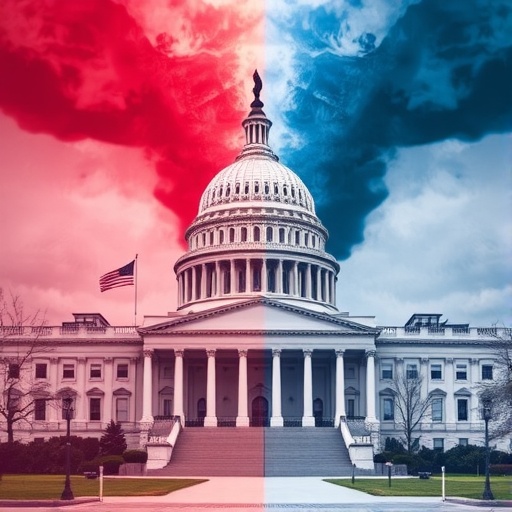Congress Braces for Government Shutdown Showdown as Federal Budget Deadline Approaches
In the high-stakes arena of Washington politics, Congress is hurtling toward a potential government shutdown as the federal budget deadline looms just days away. With partisan lines drawn deeper than ever, lawmakers are locked in fierce negotiations over spending priorities that could halt federal operations and disrupt millions of lives across the nation. The clock is ticking—funding expires at midnight on Friday, leaving little room for error in this escalating budget battle.
This isn’t just another fiscal skirmish; it’s a pivotal moment that could redefine the legislative landscape. Republicans, led by House Speaker Mike Johnson, are pushing for steep cuts to non-defense discretionary spending, arguing it’s essential to curb the nation’s ballooning $35 trillion debt. Democrats, countering from the Senate under Majority Leader Chuck Schumer, demand protections for social programs like Medicaid and food assistance, warning that any slashes would devastate vulnerable communities. As tensions flare on Capitol Hill, the specter of a government shutdown—last seen in late 2023—looms large, threatening everything from national parks to military paychecks.
Behind the rhetoric, the stakes are enormous. A shutdown would furlough hundreds of thousands of federal workers, delay Social Security checks, and grind agency operations to a halt. Economists estimate each day of closure costs the U.S. economy up to $1.5 billion in lost productivity. "We’re on the edge of a cliff," said Sen. Lindsey Graham (R-S.C.) in a fiery floor speech. "If we don’t act, the American people will pay the price for Washington’s gridlock."
Spending Clashes Erupt Over Defense and Social Programs
The core of the federal budget impasse lies in irreconcilable views on spending allocations. Republicans have proposed a $1.6 trillion topline budget that prioritizes a 2% increase in defense funding to $895 billion, citing rising global threats from China and Russia. However, they seek a 10% reduction in non-defense discretionary spending, which funds education, environmental protection, and housing programs—totaling about $700 billion annually.
Democrats view this as an assault on the social safety net. "You can’t build a strong military on the backs of starving children," retorted House Minority Leader Hakeem Jeffries (D-N.Y.) during a press conference. Senate Democrats have introduced an alternative bill that maintains level funding for social services while adding $50 billion for infrastructure repairs, drawing from the 2021 Bipartisan Infrastructure Law. The divide is stark: GOP amendments have already blocked Democratic priorities like expanding child tax credits, which could lift 400,000 children out of poverty according to the Center on Budget and Policy Priorities.
Negotiations in the House Appropriations Committee have stretched into the wee hours, with procedural votes stalling progress. One key flashpoint is border security funding—Republicans demand $20 billion more for wall construction and deportation efforts, while Democrats tie it to comprehensive immigration reform. As of Wednesday, the House passed a slimmed-down continuing resolution (CR) by a razor-thin 217-215 margin, but it faces certain doom in the Senate without concessions.
Experts point to inflation as a complicating factor. With consumer prices up 3.2% year-over-year per the latest Bureau of Labor Statistics data, both sides accuse the other of fiscal irresponsibility. "The federal budget isn’t a zero-sum game; it’s about smart investments," noted Maya MacGuineas, president of the Committee for a Responsible Federal Budget. Her organization warns that without a deal, the impasse could trigger automatic spending cuts under the 2011 Budget Control Act sequels.
Past Shutdowns Cast Long Shadows on Current Talks
Memories of previous government shutdowns are fueling the urgency in Washington. The 2018-2019 closure, the longest in history at 35 days, cost an estimated $11 billion in economic damage and furloughed 800,000 federal employees. National parks closed, leading to $250 million in lost tourism revenue, and IRS tax refunds were delayed for weeks. "Families suffered then, and they’ll suffer again if we repeat those mistakes," said Rep. Alexandria Ocasio-Cortez (D-N.Y.), who experienced the fallout firsthand as a new member of Congress.
More recently, the 2023 mini-shutdown averted at the eleventh hour highlighted ongoing dysfunction. That near-miss involved similar spending disputes, with conservatives in the House Freedom Caucus rebelling against Speaker Johnson’s initial CR. This time, the group—now holding 45 seats—has vowed to vote down any bill lacking deeper cuts, potentially forcing a leadership crisis. "We’re not bluffing," declared Rep. Chip Roy (R-Texas), a vocal Freedom Caucus member.
Historical data from the Congressional Research Service shows 21 shutdowns since 1976, averaging 7.5 days each, but the political fallout has grown. Public approval for Congress hovers at a dismal 18% according to Gallup polls, and a shutdown could plummet it further. Bipartisan groups like the Problem Solvers Caucus are attempting bridge-building, proposing a compromise CR that extends funding through March with minor adjustments. Yet, with President Biden’s State of the Union looming next month, neither party wants to appear weak.
The ripple effects extend beyond D.C. In 2019, the shutdown led to a 40% spike in food bank usage in affected areas, per Feeding America reports. Veterans’ benefits were disrupted, and air traffic controllers worked without pay, raising safety concerns. Lawmakers are acutely aware: a new shutdown could alienate swing-district voters ahead of the 2024 midterms, where control of Congress hangs in the balance.
White House Steps In with Urgent Calls for Unity
From the Oval Office, President Joe Biden has ramped up pressure on Congress to avert disaster. In a Rose Garden address Tuesday, he urged lawmakers to "put politics aside and pass a clean federal budget that honors our commitments to the American people." The White House has circulated a framework emphasizing green energy investments—$100 billion from the Inflation Reduction Act—at the expense of fossil fuel subsidies, a non-starter for many Republicans.
Vice President Kamala Harris hosted a closed-door meeting with moderate senators from both parties, emerging with cautious optimism. "There’s common ground on disaster relief funding after last year’s hurricanes," she told reporters, referencing the $50 billion needed for FEMA replenishment. However, hardliners remain unmoved. Senate Minority Leader Mitch McConnell (R-Ky.) issued a statement criticizing Democratic "wish-list spending" as inflationary, echoing concerns from the Federal Reserve about persistent price pressures.
Lobbyists are swarming Capitol Hill, with business groups like the U.S. Chamber of Commerce warning of supply chain disruptions. "A shutdown would be catastrophic for small businesses already reeling from post-pandemic recovery," said Chamber President Suzanne Clark. Labor unions, including the AFL-CIO, are mobilizing protests, demanding no cuts to worker protections. The cacophony underscores the federal budget’s role as the economy’s backbone—discretionary spending alone supports 10 million jobs nationwide, per the Joint Economic Committee.
Internationally, the drama isn’t helping America’s image. Allies in NATO are watching closely, as a U.S. shutdown could delay $61 billion in Ukraine aid tied to the budget. "Washington’s internal fights weaken our global standing," opined former Secretary of State Condoleezza Rice in a CNN interview.
Economic and Social Fallout Threatens Millions
Beyond the Beltway, the potential government shutdown’s tentacles reach every corner of America. Federal employees—over 2.1 million civilians—face unpaid leave, with many dipping into savings or relying on food pantries. In fiscal year 2019, shutdown workers lost an average of $1,300 each, according to Treasury Department data. Military personnel, though paid via emergency funds, often see delayed reimbursements, straining family budgets.
Social services would grind to a halt: Head Start programs for low-income preschoolers could close, affecting 800,000 children. SNAP benefits (food stamps) might continue briefly but face processing delays, exacerbating hunger for 42 million recipients. "This isn’t abstract—it’s about real people skipping meals," said Stacy Dean, USDA undersecretary, in testimony before the Senate Agriculture Committee.
The economy faces broader tremors. Stock markets dipped 1.2% on Monday amid shutdown fears, with the Dow Jones shedding 450 points. Travel and tourism sectors, still recovering from COVID, brace for pain—national parks like Yellowstone could shutter, costing $40 million daily in visitor spending. Airlines warn of FAA staffing shortages leading to flight delays, while ports might see customs backlogs delaying imports worth billions.
Minority and rural communities stand to lose most. A 2023 Urban Institute study found shutdowns disproportionately hit Black and Hispanic workers in federal jobs. In Appalachia, where federal grants fund water infrastructure, delays could worsen public health crises. Women, who comprise 44% of the federal workforce, often bear the brunt through lost childcare access.
Yet, some see silver linings in reform pushes. Advocacy groups like the National Priorities Project argue a shutdown could spotlight wasteful spending, such as the $800 billion Pentagon budget’s overlaps. "Use this crisis to audit and streamline," urged their executive director, Hannah Pittman.
Negotiators Race Toward a Fragile Deal or Deeper Crisis
As the deadline nears, backroom talks in Washington are intensifying, with Speaker Johnson and Leader Schumer huddling in the Capitol’s ornate conference rooms. A tentative outline emerged late Wednesday: a short-term CR funding the government through April, paired with a bicameral commission to tackle long-term spending reforms. But sticking points persist—Democrats want guarantees against future debt ceiling fights, while Republicans insist on border security riders.
If no deal materializes, contingency plans kick in. The Pentagon has prepared to secure nuclear sites with minimal staff, and the TSA vows to keep airports operational, albeit with longer lines. Essential services like air traffic control and border patrols would continue, but non-essential functions freeze. Congress itself might recess, leaving constituents in limbo.
Looking ahead, resolution could reshape the federal budget landscape. Success might embolden bipartisan efforts on issues like AI regulation or climate adaptation. Failure, however, risks eroding trust in institutions, potentially fueling populist surges in upcoming elections. Analysts from Brookings Institution predict a 60% chance of shutdown avoidance, but warn of "shutdown lite" scenarios with partial closures.
For everyday Americans, the message is clear: brace for uncertainty. Community organizations are stockpiling resources, and financial advisors urge building emergency funds. As one Capitol Hill staffer put it anonymously, "This federal budget fight is Congress’s wake-up call—fix it now, or pay later." With eyes on Friday’s midnight hour, the nation holds its breath for a breakthrough or breakdown.









